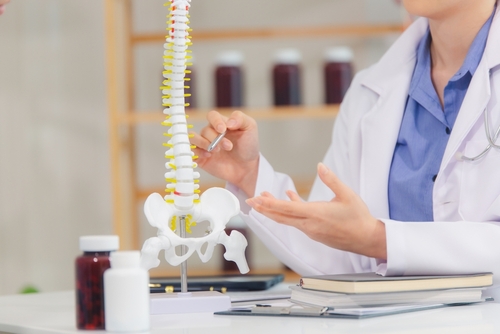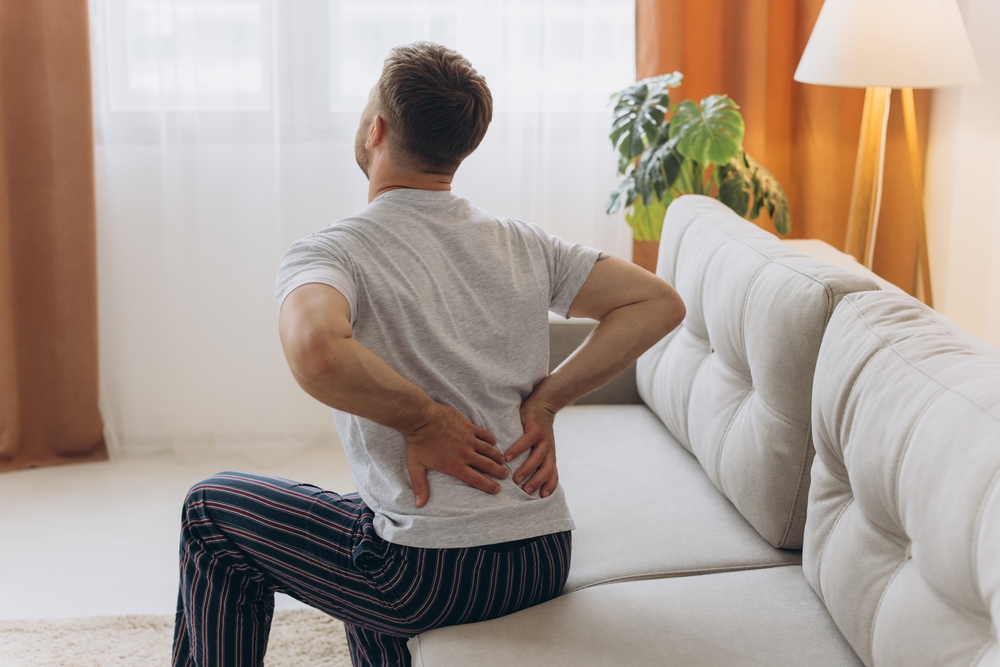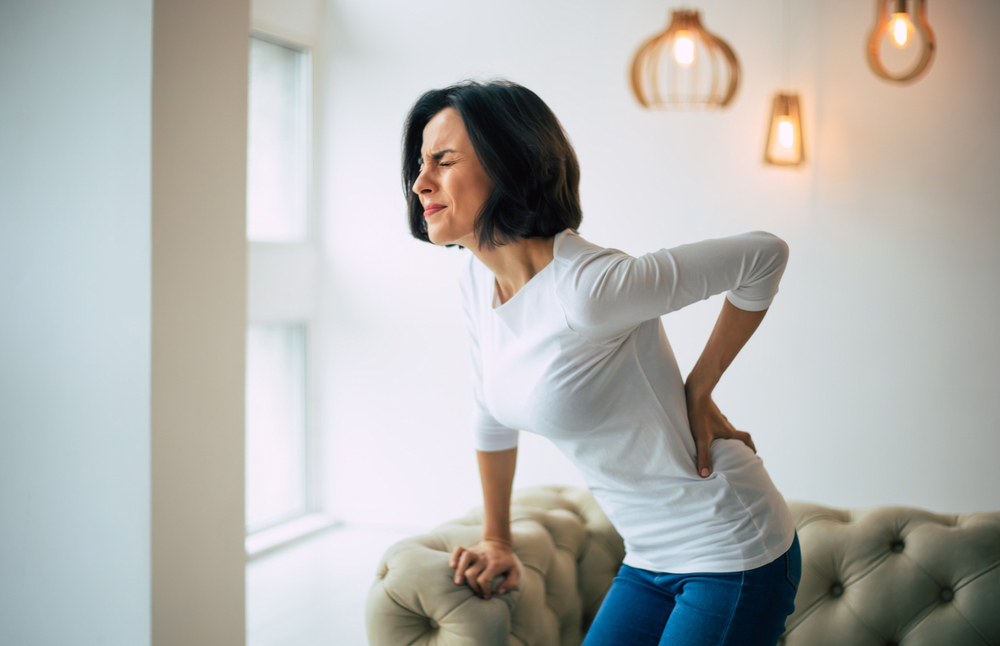Back pain is one of the most common health issues people experience, affecting individuals of all ages and lifestyles.
In this article, we’ll break down the most common types of back pain people encounter, explore their possible causes, and offer practical remedies to help manage discomfort.
Understanding the nature of your back pain can be the first step toward finding the relief you need.
A. Back Pain By Area
1. Upper Back Pain (Thoracic Spine)
- What it Feels Like: Pain located between the shoulder blades or the upper part of the back.
- Possible Causes:
- Poor posture (especially from sitting at a desk or using a computer)
- Muscle strain or tension
- Joint dysfunction (facet joints)
- Herniated disc (though less common in the upper back)
- Scoliosis
- Remedies to Try:
- Posture correction and ergonomic adjustments
- Stretching and strengthening exercises for the shoulders and upper back
- Massage or chiropractic care
- Ice or heat therapy to relax muscles
- Over-the-counter pain relievers
2. Lower Back Pain (Lumbar Spine)
- What it Feels Like: Dull, aching, or sharp pain in the lower back. It may radiate down the legs (sciatica) or remain localized.
- Possible Causes:
- Muscle strain or ligament sprain
- Herniated or bulging disc
- Sciatica
- Spinal stenosis
- Arthritis
- Spondylolisthesis
- Remedies to Try:
- Rest and avoid heavy lifting or twisting movements
- Stretching exercises targeting the hamstrings, hip flexors, and lower back
- Physical therapy to strengthen the core
- Anti-inflammatory medications (NSAIDs)
- Heat or cold packs to reduce inflammation or loosen muscles
If you want to learn more, we also have a post dedicated to managing lower back pain.
3. Middle Back Pain
- What it Feels Like: Pain in the mid-back area, often more intense when twisting or moving.
- Possible Causes:
- Muscle strain (from overuse or poor posture)
- Spinal misalignment or scoliosis
- Herniated or degenerative disc
- Joint or facet dysfunction
- Kidney problems (if the pain is deeper and near the sides)
- Remedies to Try:
- Gentle stretches and exercises to relieve muscle tension
- Proper posture and ergonomic improvements, especially while sitting
- Massage therapy
- Ice or heat therapy
- Medical evaluation if there is concern about organ-related causes (e.g., kidney issues)
4. Lower Back and Leg Pain (Sciatica)
- What it Feels Like: Pain that starts in the lower back and radiates down one or both legs, often with tingling or numbness.
- Possible Causes:
- Herniated disc pressing on the sciatic nerve
- Spinal stenosis
- Piriformis syndrome (a muscle pinching the sciatic nerve)
- Spondylolisthesis
- Remedies to Try:
- Physical therapy and stretching to relieve pressure on the sciatic nerve
- Anti-inflammatory medications
- Rest and avoid activities that aggravate the pain
- Chiropractic care or spinal adjustments
- Pain relief techniques like ice or heat therapy
5. Upper Back and Neck Pain (Cervical Spine)
- What it Feels Like: Pain located in the upper back and neck, often accompanied by headaches or shoulder pain.
- Possible Causes:
- Poor posture (forward head posture or rounded shoulders)
- Muscle strain from holding the head in one position too long
- Herniated cervical disc
- Whiplash or other neck injuries
- Cervical spondylosis (wear and tear of the spine)
- Remedies to Try:
- Posture correction exercises
- Neck and shoulder stretches
- Use of ergonomic pillows and chairs
- Ice or heat therapy
- Over-the-counter pain medications (NSAIDs)
- Chiropractic or physical therapy
6. Tailbone Pain (Coccyx Pain)
- What it Feels Like: Sharp or aching pain at the very bottom of the spine, particularly when sitting.
- Possible Causes:
- Injury or trauma to the tailbone (coccyx)
- Prolonged sitting on hard surfaces
- Childbirth-related injury
- Degenerative joint issues
- Infections or tumors (rare but possible)
- Remedies to Try:
- Use of a cushioned seat or “donut” pillow to relieve pressure
- Avoid sitting for extended periods or adjust sitting posture
- Ice therapy to reduce inflammation
- Gentle stretches for the pelvic floor and lower back
- Physical therapy if the pain persists
7. Pain Along One Side of the Back
- What it Feels Like: Pain localized to either the left or right side of the back, can be dull or sharp, and may worsen with movement.
- Possible Causes:
- Muscle strain from overuse or imbalanced movement
- Kidney stones or infections (if the pain is near the flank area)
- Sciatica (if the pain radiates down the leg)
- Rib joint dysfunction or costochondritis (pain near the ribs)
- Remedies to Try:
- Gentle stretching and massage to relieve muscle tension
- Apply ice or heat to the affected area
- Ensure proper hydration (especially if kidney-related)
- Visit a doctor if the pain is severe or if there are symptoms like fever (kidney issues)
8. Upper Back Pain Radiating to the Chest
- What it Feels Like: Pain in the upper back that extends to the chest, sometimes mistaken for heart-related issues.
- Possible Causes:
- Costochondritis (inflammation of the cartilage connecting the ribs to the breastbone)
- Muscle strain in the chest or upper back
- Pinched nerve
- Heart conditions (if accompanied by other symptoms like shortness of breath, seek emergency care)
- Remedies to Try:
- Rest and avoid activities that strain the chest and upper back
- Ice or heat therapy for muscle relaxation
- Anti-inflammatory medications
- Visit a doctor to rule out serious causes if the pain persists or worsens
9. Pain Around the Shoulder Blades
- What it Feels Like: Aching, burning, or stabbing pain around the shoulder blades.
- Possible Causes:
- Muscle strain from poor posture or repetitive movements
- Thoracic spine herniation (rare)
- Referred pain from gallbladder or liver issues
- Nerve impingement
- Remedies to Try:
- Posture correction and ergonomic adjustments (especially for desk work)
- Stretching and strengthening exercises for the upper back
- Massage or foam rolling
- Heat therapy to loosen tense muscles
- Medical evaluation if pain is persistent or unusual
B. Back Pain By Activity
1. Back Pain When Waking Up
- What it feels like: Stiffness, aching, or sharp pain felt in the morning, typically subsiding after moving around for a while. Commonly felt in the lower back.
- Possible causes:
- Poor sleeping posture
- Unsupportive mattress or pillows
- Muscle stiffness from lack of movement overnight
- Degenerative disc disease
- Inflammatory conditions (e.g., arthritis)
- Remedies to try:
- Improving sleep posture (sleeping on your back or side with a pillow between your knees)
- Using a supportive mattress and pillow
- Gentle morning stretches or yoga to loosen muscles
- Heat therapy in the morning to relax muscles
- Regular exercise to improve flexibility and back strength
You might also want to read our post on how to sleep with lower back pain.
2. Back Pain After Walking
- What it feels like: Pain that develops or worsens after walking, usually in the lower back. Can be dull or sharp, and may radiate down the legs.
- Possible causes:
- Poor posture or gait while walking
- Weak core muscles
- Spinal stenosis
- Sciatica or nerve compression
- Footwear that lacks support or causes strain
- Remedies to try:
- Wearing supportive, comfortable shoes
- Practicing good walking posture (keeping your back straight and shoulders back)
- Core-strengthening exercises to stabilize the spine
- Taking breaks if walking for long periods
- Physical therapy for posture and gait correction
3. Back Pain After Being Active
- What it feels like: Aching, soreness, or sharp pain that arises after physical activity, such as exercise, lifting, or other strenuous activities.
- Possible causes:
- Overuse or strain of the back muscles
- Poor form or technique during physical activity
- Weak back or core muscles
- Muscle sprain or ligament injury
- Herniated disc or other spinal issues
- Remedies to try:
- Rest and allow time for recovery
- Apply ice or heat, depending on whether the injury is acute (ice) or due to muscle soreness (heat)
- Ensure proper form when lifting or exercising
- Stretching before and after activity to prevent stiffness
- Gradual strength training to build up back and core muscles
- Seek medical advice for more severe or persistent pain, especially if accompanied by numbness or weakness
We have an additional resource if you are experiencing back pain while bending forward.
4. Back Pain When Sitting
- What it feels like:
-
- Dull, aching pain or sharp discomfort in the lower back
- Intensifies the longer you sit
- Pain may radiate to hips or legs
- Possible causes:
-
- Poor posture (slouching or leaning forward)
- Prolonged sitting with little movement
- Weak core muscles
- Disc problems (e.g., herniated disc)
- Sciatica or nerve compression
- Inadequate chair support
- Remedies to try:
-
- Improve posture by sitting with your back straight and feet flat on the ground
- Use a chair with proper lumbar support or add a lumbar cushion
- Take frequent breaks to stand and stretch every 30-60 minutes
- Strengthen core muscles through exercises like planks
- Adjust your workstation to promote better ergonomics (e.g., monitor at eye level)
- Sit on an exercise ball or use a sit-stand desk to encourage movement
5. Back Pain When Standing
- What it feels like:
-
- Persistent or sharp pain in the lower back
- Increases when standing for long periods
- Pain may radiate through the buttocks or legs
- Often relieved when sitting or lying down
- Possible causes:
-
- Poor posture when standing (e.g., leaning forward, uneven weight distribution)
- Weak or imbalanced core and back muscles
- Spinal misalignment or scoliosis
- Muscle fatigue or strain from prolonged standing
- Degenerative disc disease
- Conditions like sciatica or spinal stenosis
- Remedies to try:
-
- Practice proper standing posture (shoulders back, weight evenly distributed)
- Wear supportive footwear to reduce pressure on the back
- Use a cushioned mat if standing on hard surfaces for long periods
- Strengthen back and core muscles through regular exercise
- Take breaks to sit or move when standing for extended periods
- Stretch and do gentle exercises like yoga to improve flexibility and muscle balance
Should I Go to the Doctor for My Back Pain?
It’s definitely important to consider if your back pain is something you should treat at home or if it is something you should see a medical professional about.
Mild, occasional pain caused by poor posture, muscle strain, or overexertion can often be managed at home with rest, ice or heat therapy, and over-the-counter medications.
However, if your pain persists for more than a few weeks, intensifies, or is accompanied by other symptoms—such as numbness, tingling, or weakness in your legs—it may be time to seek medical advice.
Additionally, if you experience severe pain after a fall or injury, notice unexplained weight loss, or have difficulty controlling your bladder or bowels, you should see a doctor immediately.
These could be signs of a more serious condition, and early intervention can help prevent further complications. If you want to understand more about back pain and what professional treatment looks like, you can read our full guide on back pain here.
PinPoint Health Can Help
Our team is here to help you find the right treatment plan and get you back to feeling your best. Feel free to book an appointment with us any time!
We have clinics throughout the GTA in: Toronto, Markham, Etobicoke, Brampton, Maple, Mississauga, Newmarket, Woodbridge, Oakville, and Vaughan.





